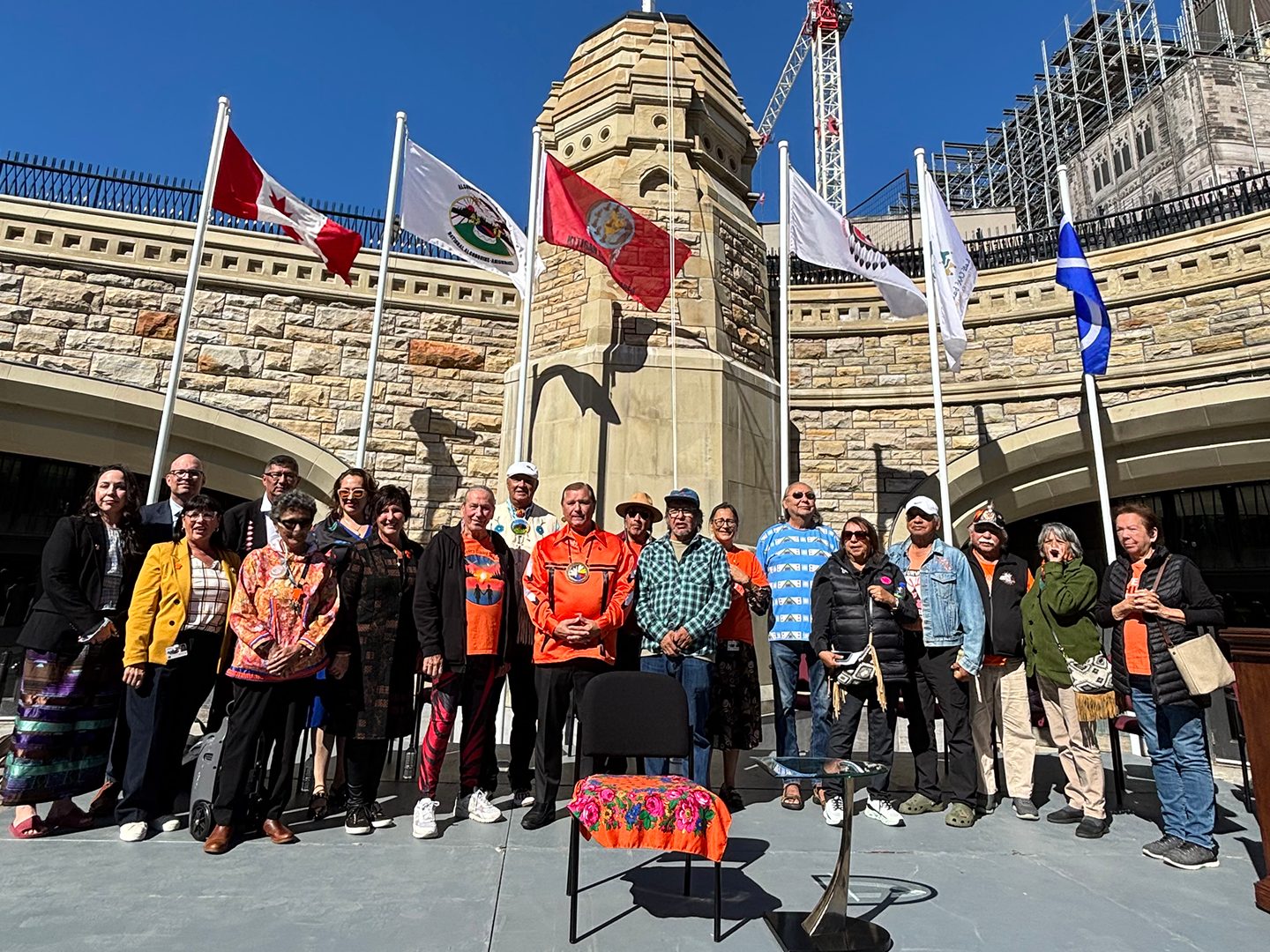Survivors’ Flag Raised in Honour and Remembrance on Parliament Hill

October 1, 2025 — Ottawa, unceded Algonquin Traditional Territory, Ontario — Crown-Indigenous Relations and Northern Affairs Canada and National Centre for Truth and Reconciliation
Today First Nations, Inuit, and Métis Residential School Survivors gathered on Parliament Hill, unceded territory of the Anishinabeg Algonquin, to re-raise the Survivors’ Flag in honour of Residential School Survivors and in memory of the children who never returned home.
Survivors, Elder Claudette Commanda, and the National Centre for Truth and Reconciliation (NCTR) were joined at this commemorative event by leaders of National Indigenous Organizations, Her Excellency the Right Honourable Mary Simon, Governor General of Canada, and the Honourable Rebecca Alty, Minister of Crown-Indigenous Relations.
Residential schools forcibly separated Indigenous children from family and community, and subjected them to abuse and neglect and prohibited from practising their cultures, traditions, and languages. The trauma imposed by this system continues to reverberate for Survivors and the generations that followed.
The Survivors’ Flag reminds us all of this shameful treatment endured by Indigenous Peoples in Canada and symbolizes Canada’s ongoing commitment to reconciliation.
Quotes
“Re-raising the Survivors Flag on Parliament Hill is more than a gesture; it is a profound act of reconciliation and a public commitment to honour a promise to Survivors. It reminds us of our responsibility to acknowledge the past, understand its ongoing impacts, and to work together to build a better future. This flag stands as a national symbol of our people’s enduring strength, showing Canada that we are here—we have always been here—as our collective journey toward healing continues.”
Elder Claudette Commanda
Algonquin Anishinabeg Nation
“The Bentwood Box and the Survivors’ Flag are sacred items to learn about the truth. Truth and reconciliation is a commitment to understand and learn about the true history of residential schools. Our history, who we are as people, and our truths can never be forgotten or dismissed. We will continue the fight to be heard and more importantly – validated.”
Eugene Arcand
Cree Survivor
“As a residential school Survivor, seeing the Survivors Flag on Parliament Hill brings up mixed emotions. It’s a reminder of the pain from my youth—of being torn from my home, family, culture, and identity. But it also means my truth is no longer hidden. It gives me hope that Canada is ready to do what is right and that the promise to do better is a commitment to action, not just words.”
Edna Elias
Inuit Survivor
“When I see the Survivors’ Flag flown, it gives me hope. Hope that reconciliation is within reach. Hope that there are better days ahead for our relatives and our future generations – they are the ones who will carry our truths forward so that history cannot be forgotten.”
Charlotte Nolin
Métis Survivor
“We are living in difficult times, facing daily challenges that can feel overwhelming. It is critical that we never lose sight of the true history of this country. Today, as we raise the Survivors Flag, we are reminded of the strength of Survivors and the essential work of reconciliation. This year, as it is the 10th anniversary of the TRC’s Final Report and 94 Calls to Action, this flag serves as a powerful reminder of our commitment to honouring the past and building a better future.”
Stephanie Scott
Executive Director, National Centre for Truth and Reconciliation
“In sharing their experiences and preserving the truth, Survivors help educate us about our past and make it possible for us to move forward on the path to reconciliation. We raise this flag on Parliament Hill to honour them and lift them up. Let the Survivors’ Flag serve as a reminder to all Canadians of our collective responsibilities: to remember, to act, and to walk forward, together.”
The Honourable Rebecca Alty
Minister of Crown-Indigenous Relations
Quick Facts
- The Survivors’ Flag was first raised on Parliament Hill in August 2022. It was created by and for Survivors, to honour all Survivors, families, and communities impacted by the residential school system in Canada and share their expression of remembrance.
- The Flag was developed through consultation and collaboration with Inuit, Mi’kmaq, Atikamekw, Cree, Ojibway, Dakota, Mohawk, Dene, Nuu-chah-nulth, Secwepemc, and Métis Nation Survivors.
- The National Centre for Truth and Reconciliation (NCTR), hosted by the University of Manitoba, was created as a place of learning where the truths of Survivors are honoured and kept safe for future generations.
Associated links
National Centre for Truth and Reconciliation
Crown-Indigenous Relations – The Reconciliation Journey
